#natsume nobuko
Text
The BSD Most Gender Debate
Round One!
17 notes
·
View notes
Text
Miscellaneous characters
Adam Frankenstein (#adam frankenstein)
Architect (#bsd architect)
Dan Brown (#dan brown)
Herbert George Wells (#herbert george wells)
Jules Verne (#jules verne)
Katsura Shōsaku (#katsura shōsaku)
Kōda Aya (#kōda aya)
Kyōgoku Natsuhiko (#kyōgoku natsuhiko)
Murakami Tokio (#murakami tokio)
Natsume Sōseki (#natsume sōseki)
Sasaki Nobuko (#sasaki nobuko)
Shibusawa Tatsuhiko (#shibusawa tatsuhiko)
Taguchi Rokuzō (#taguchi rokuzō)
Yokomizo Seishi (#yokomizo seishi)
#bsd masterlist#adam frankenstein#bsd architect#dan brown#herbert george wells#jules verne#katsura shōsaku#kōda aya#kyōgoku natsuhiko#murakami tokio#natsume sōseki#sasaki nobuko#shibusawa tatsuhiko#taguchi rokuzō#yokomizo seishi
9 notes
·
View notes
Text
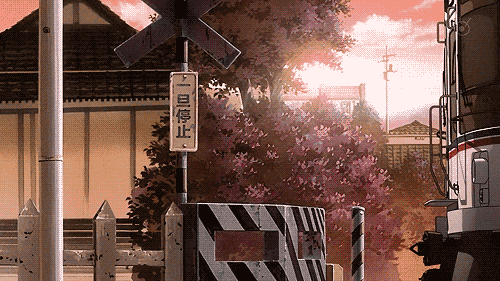
𝙱𝚂𝙳 𝙼𝚊𝚜𝚝𝚎𝚛𝚕𝚒𝚜𝚝
(aus mixed)
dividers by cafe kitsune

𝙾𝚝𝚑𝚎𝚛
Ango Sakaguchi: @themafiasinformant @discourse-on-decadence
Agatha Christie: @agathachristiebsd
Soseki Natsume: @natsume-the-kitty
Tatsuhiko Shibusawa: @eternalboredom @draconia777
Aya Koda: @worldsbiggesthero @ayayakoda
"Belladonna": @cafe-uzumaki
Nobuko Sasaki: @theazureapostle
Oguri Mushitaro: @still-the-perfect-crime
Gonchaov Ivan: @headchamberlain
Albatross: @albatross-from-the-pm @the-real-albatross
Doc:
Iceman: @hitmanmafioso
Pianoman: @i-make-counterfeit-notes (it wont let me tag you </3)
Lippmann: @stoicsleuth
Adam: @europolesbestdetective
Beast dazai: @yearningfortheend
Beast chuuya: @sorrowfulslug @snowydusk
25 notes
·
View notes
Text
𝓑𝓼𝓭 𝓜𝓪𝓼𝓽𝓮𝓻𝓵𝓲𝓼𝓽 - 𝓡𝓪𝓷𝓭𝓸𝓶 𝓟𝓮𝓸𝓹𝓵𝓮 𝓪𝓷𝓭 𝓣𝓱𝓮 𝓢𝓱𝓮𝓮𝓹

comment/ send an ask if you have anymore I need to add!
this masterlist is broken up because of errors with all of the @'s I had
------------------
тнє ѕнєєρ
Shirase Buichirou -
Yuan - @yuanisim
Chuuya Nakahara - @notthekingofthesheep
-----------------
σтнєя
Mizuki Tsujimura -
Agatha Christie - @agathachristiebsd
Aya Koda - @worldsbiggesthero, @ayayakoda
Ivan Goncharov - @headchamberlain
Mushitaro Oguri - @still-the-perfect-crime, @official-lord-of-perfect-crimes, @lordofcrimes
Andre Gide -
H.G Wells - @hgw3lls
Shibusawa Tatsuhiko - @eternalboredom, @tatsuhikoshibusawa
Natsume Soseki - @natsume-the-kitty
Sasaki Nobuko - @theazureapostle
Yukito Ayatsuji - @cold-bloodedreaper
Belladonna - @cafe-uzumaki
Karl - @karl-the-raccoon
Adam Frankenstein - @europolesbestdetective
The Orphanage Director - @outsidetherearemonsters
All of Stormbringer - @askstormbringer
16 notes
·
View notes
Text
on natsumugi, girls’ literature, and love
“Love is the key to life’s secrets. Love exists first, then there is life. If one takes away love, what is the meaning of life?”
Kitamura Tokoku, “Disillusioned poets and women” (1892)
In the process of writing a paper arguing the validity of Enstars as yuri, I got to read a lot about Yoshiya Nobuko’s 1920 novel Two Virgins in the Attic. Chronicling the story of Akiko, a lonely young woman without purpose or direction, and her relationship with a rebellious girl named Tamaki, Two Virgins is incredibly notable not just for its queerness, but also for the way it participates in the love discourse of its time.
What does any of that have to do with Natsume or Tsumugi or Enstars as a whole? Girls’ lit has a lot of crossover and noticeable traces in Enstars, but that’s not a beast for today. What I want to explore is how Natsumugi’s journey during the War arc parallels Akiko and Tamaki’s story, and in turn, how Enstars echoes modern love discourse.
“Love can be a wonderful thing to experience.” That’s what Natsumugi makes me feel. They surrender themselves to it, letting themselves be scorched by flames, and from the ruins build themselves up again, as new people from the same material, within themselves a little bit of the other. They become intertwined. I want to try and break down that lofty feeling so I can share it with you.
i. what is ‘modern love discourse’?
Just like other abstract but incredibly proximate concepts, people have been trying to concretely define ‘love’ since time immemorial. Modern love discourse is one of those many attempts.
During the Meiji era, Japan opened up to the rest of the world after a long period of national isolation and began absorbing Western influence like crazy. One of the concepts they were eager to adapt was Christian love. This was in stark contrast to tradition Japanese conceptions of love, which were focused more on the physical and carnal. Spiritual in nature, that is, recontextualizing love as a pathway to not only physical pleasure but also spiritual/intellectual/internal fulfillment (self-realization, basically); and emphasizing purity, monogamy, and the institution of the family, Japan viewed this new idea as an asset in nation-building. Hence the heterosexual and nationalistic undertones in a lot of modern love discourse.
The opening quote to this essay is a good example of this. It’s from Kitamura Tokoku, a prominent writer during the Meiji era. (I encourage you to go back and give it another read or two before proceeding!) It’s a pretty concise and simple way to describe the majority outlook on love at the time: through experiencing love, we learn more about ourselves and find our place in the world. That place being... becoming a productive member of society by marrying and reproducing.
Love is generative. It is union, creation, and foundation. People live to pursue the goal of (heterosexual) love, in order to attain its rewards: wholeness of self, a purpose in the world. Without love, people are unable to live a full life.
Pretty rigid, isn’t it? It’s het and pretty focused on clear-cut romance. It assumes everyone wants to get married or have kids or has the capability to do either. Not too far from our society now, really; we still glorify (romantic—and heterosexual, I am thinking about comphet here) love as an important milestone in life. The dominant perception of love in modern Japan clearly privileged straight men. What about the women? And more pertinently, what about the queers?
There were certainly feminists who contributed to the discourse, but often they remained attached to the idea of marriage leading to fulfillment; in its engagement with queerness, one of the most prominent feminists of the time, Hiratsuka Raicho, actually disavowed same-sex relationships between women after getting married, despite previously having been in one herself and speaking fondly of it.
But queerness still sneakily found its way into the discourse through girls’ literature, due in no small part to the influence of lesbian writer of popular fiction, Yoshiya Nobuko.
ii. how does two virgins queer modern love discourse?
As a quick definition, girls’ literature or fiction here pertains to any written work meant for an audience of girls. While the term initially referred to novel-length narrative pieces, now it’s more or less an umbrella term. Modern girls’ literature was published in girls’ magazines, to be read by children and schoolgirls.
Written in an ornate, flowery prose that borrowed from classical Japanese literature, girls’ literature often told stories of unrequited love or passionate friendships between girls. These relationships were termed S-relationships or sister relationships; often, they manifested a sense of distance between the girls involved, usually through differences in age or status (think student/teacher). In fiction this distance took on other forms, such as unrequited feelings, noncommunication, and even emotional unavailability.
As you might be thinking or already know, S-relationships seem pretty gay. If we want to be period-accurate (which means doing away with labels like gay or lesbian), then S-relationships are a form of same-sex relationships. They were not just a literary trope but an actual real-life phenomenon; both its practice and literary representation was allowed because it was seen as normative, a way to prepare young girls for heterosexual partnerships while protecting their purity because “there’s no way girls would have sex with each other! They’re pure schoolgirls!” In the cases girls did have sex, the relationship was seen as deviant and harmful. Same goes for the instances when two girls would attempt a lovers’ suicide because they couldn’t be together after graduation, or once they got married.
A lot of girls’ fiction about S-relationships ended in tragedy as a result of those attitudes. Usually, one of the girls dies; sometimes one of them must leave, never to be seen again; other times there’s the responsibility of marriage and motherhood which is greater than the bond between two Best Friends And Something More (But Not Lovers, Not At All). It’s easy to see that and think “Oh no, the lesbians have been buried again!” and/or “Wow, so queerness here is a phase, huh.” In other words, girls’ lit seems like it bends to the will of the productive, heterosexual order of modern Japanese society.
But ‘a lot’ isn’t ‘all,’ and anyway, whether the tragedy of girls’ lit is positive or negative is an entirely different discussion from this one. Perhaps to your relief, Two Virgins in the Attic has a happy, liberatory ending for its queer couple: the titular virgins, Akiko and Tamaki.
Akiko is introduced as a girl who lacks a purpose in life. Struggling to pass in school and having distanced herself from her Christian faith, Akiko is evicted from her religious school’s dorm and forced to move to a new one. Her new room, the titular attic, is shaped unconventionally as a triangle, mirroring Akiko’s own feelings of detachment from people around her. She begins to see the attic as a safe space, the only place she can feel she truly belongs. This escapist fantasy is her sole happiness which allows her to bury her feelings of inadequacy and alienation, as well as distance herself from her social responsibilities as a young woman. However, beyond her beloved attic lies reality, which Akiko must eventually confront.
Despondent with her imminent loss of youth and lack of direction in life, Akiko meets Tamaki, her new roommate. A kindred rebellious spirit, but much more outspoken, Tamaki quite literally brings Akiko outside of her shell, taking her to meet new people, experiencing new things in the city, and teaching her about finding herself and her own path. Akiko develops romantic feelings toward Tamaki, which are returned, and the two form a bond that ultimately drives both girls out of the attic for good, and into the real world.
Throughout the novel, Yoshiya includes characters who have chosen to forsake same-sex love for heterosexual unions. One of these is the character Kinu, who appears towards the end of the novel. She is a beautiful older girl who was once involved with Tamaki. Unhappy and unfulfilled in marriage, and with nary a way out, she seeks out her old flame to ask if they could attempt a lover’s suicide. Kinu’s proposal poses not only a grave threat to Akiko and Tamaki’s relationship, but also represents the supposed destructive nature of same-sex unions; yet Yoshiya subverts this by clearly making Kinu’s misery in marriage the rationale for her extremity.
Heterosexual partnerships are painted as limiting and destructive for women, especially with regard to their own self-development and actualization. Conversely, through Akiko and Tamaki, same-sex love is seen as conducive for this development.
While their bond brings many good things to Akiko, it also surfaces her insecurities when Kinu enters the picture. She grows incredibly jealous of Kinu, and these feelings drive a wedge between her and Tamaki; feeling abandoned and once again excluded from the world around her, Akiko lashes out, hitting friends who enter the attic and even destroying a doll that had been a gift from Kinu to Tamaki. This violence forces the dorm’s management to evict Akiko, giving her no choice but to enter the world she had so longed to hide from. While this may seem like a negative portrayal of same-sex love, similar to the strategy employed with Kinu, the narrative does not portray Akiko’s feelings for Tamaki as destructive. By framing it as jealousy and frustration at loneliness, same-sex love itself is not portrayed as the threat, but rather the inability to realize it.
However, Tamaki comes to Akiko as she is packing, and proposes that they leave the dorm together. This pushes Akiko to realize what direction she wants to take in life—being with Tamaki—a realization made possible not only by Tamaki’s teaching, but their union as a whole. It is through their relationship that Akiko finally finds the purpose that had been evading her from the start.
In this way, same-sex love is portrayed as equally legitimate to heterosexual unions, if not more preferable altogether. Akiko and Tamaki’s relationship guides Akiko towards her own journey to selfhood and self-actualization; through her union with Tamaki, she is able to enter a state of ‘becoming.’
iii. what’s natsumugi got to do with any of this?
Two Virgins in the Attic, to me, is a story of love and how it reinvents the self. Our main girl Akiko starts out stressing over who she is and who she should be; she is caught at a crossroads of identity, unsure of what she herself wants, paralyzed as she clings to her youth and girlhood, which is ultimately unstable. It’s relative to age and societal perception; she can’t be a maiden forever, eventually she will become an old maid. The one thing she believes and wants herself to be, she doesn’t even have control over.
Akiko reminds me of Natsume.
I think about this a lot, but you can read the war as Natsume’s bildungsroman. It’s his story of education—preconceptions of himself and the world around him are totally shattered, he is forced into an uncomfortable, unfamiliar position (that of powerlessness and a lack of control); these events force him to grow up, to leave the fantasies of his childhood with the new, more weathered outlook the experience has left him with. Of course, relationship troubles with your roommate are a different ball game from the psy-op that is the war, but Akiko and Natsume go through incredibly similar journeys. In the end, it’s through love (most strikingly for the Oddballs in Natsume’s case) that they realize what they truly want, and it’s also love which guides them to a new purpose.
Tamaki is this mentor-character who teaches Akiko so much without us ever really getting into her head and understanding her views and side of the story, which makes it simultaneously extremely easy and difficult for me to put her as a parallel to Tsumugi.
Clearly, both of them are the catalysts for Natsume/Akiko’s change. Like, Natsume’s name gets brought up as an Eccentrics candidate because of Tsumugi. If not for that, maybe his first year would have been less traumatizing. Regardless of the reason behind Tsumugi bringing him up—did he recognize him from the get-go or no?—the fact remains that Tsumugi influenced the course of Natsume’s path during the war. Plus, even when he knew the Sakasaki Natsume of the rumor mills was his dear childhood friend Natsume-chan, he made no moves to remove him from the conflict. But on the flip side, Natsume is also the catalyst for Tsumugi’s change—extremely evident with “I really love that child,” and “You taught me pain... and everything else.”
Tsumugi’s struggles with minimizing his existence mirrors Akiko’s desperation to cling to her girlhood; in turn, we can say that Tsumugi’s comfort in diminishing himself is like Natsume’s stubborn belief in his own greatness and other childhood fantasies. These attitudes are both remnants of childhood that they refuse to let go. It is their comfort zone and what they know to be true and right in the world. If we keep with the coming-of-age theming, it’s their marker of immaturity. (I know it’s way more complicated for Tsumugi because of family and trauma and everything, but work with me!)
“Okay, sure, that makes enough sense. But the war had Natsumugi fighting against each other. Where’s the love in that? If anything, they only show any ‘love’ to the other in the aftermath,” you might be thinking.
Well, yeah! (Partly because during the war itself, they had different objects of affection; Eichi for Tsumugi, his nii-sans for Natsume. I’ve written something on Natsume’s love for the Oddballs already and there’s a lot to say for Eimugi, but I digress. I do want to point out that Natsume never really stopped caring about Tsumugi, even during the war. The intensity of his feelings of betrayal makes that pretty clear. On the flip side... there was definitely some tunnel vision and delusionality going on.)
It’s at the end when they do anything caring or ‘loving’ to the other. That’s because by then, they’re completely spent and alone. They’re spoils of war; lacking purpose, lacking direction, lacking motivation and ambition. By the end of the war, Tsumugi has never been more content with living a small and mediocre existence. Natsume’s first year of high school has been ruined, and both of them are alone like never before. They only have one another.
It’s a little funny that I talked all about growing up and maturing as a result of the war, to circle back to the idea that Natsume and Tsumugi are childhood friends.
I think it’s interesting that they now have to learn how to navigate the pains of growing up together. Not because they were on opposing sides of the war, but because they’re reminders of who they used to be to each other; the ‘return to childhood’ between them is the beginning of a return to their dreams, what they wanted before they were invariably changed by that one academic year, and probably even before that. It’s a return to earnestness.
When they were kids, they both just wanted to make people (their moms) happy. That was really it; they wanted to put smiles on their faces, wanted them to be proud of their kid. After the war, they don’t just return to that dream; they discover their own rationale for pursuing it, defined by who they are now, rather than forgetting either their innocence or jadedness. They rekindle a long-dimmed spark in each other.
It is through their connection that they are able to begin their journey towards a greater, more whole selfhood—towards a future as idols—on their own terms. It is through their union that they can reconstruct themselves.
(While I drew parallels between them and Akiko/Tamaki, who are romantically involved, I don’t even think that this reading of Natsumugi has to be romantic. Like an S-relationship, it’s definitely something more than simple friendship, but not necessarily romantic. It’s like a transcendental devotion, if that makes any sense.)
Rather than saying “love is generative/productive,” I think it’s more apt and economical to say that love is transformative. It’s exactly as the meme says: to be loved is to be changed. Let me offer a different image to ponder that thought, though.
When I think of Natsumugi, I think of Prometheus. Because fire marks not an ending but a beginning; what can be destructive and violent is but an agent of change, a step forward into new frontiers, the key to doors of possibility that would otherwise never have occurred to someone. Fire creates agency in its ashes, free to scatter wherever it may please, the remnants untethered to the ground or to whatever it used to be. Its gift is a spit in the face of a god; now you've the tool to shape your fate. Now you can be anything or nothing at all.
What do we make of ash? Patience Worth gives quite a tender answer:
Who said that love was fire?
I know that love is ash.
It is the thing which remains
When the fire is spent,
The holy essence of experience.
There’s no better testament to that than Natsume and Tsumugi, together.
#enstars#ensemble stars#enstars analysis#natsumugi#natsume sakasaki#tsumugi aoba#almost 3k words long... wew#this is unedited i wrote this in one sitting please do not mind technical errors#i have lots of cool sources for the girls' lit stuff and i love talking abt it so if anyone happens 2 b curious..#plz hmu#to be honest you can go really crazy w the love discourse thing. i have tied it to the bubble economy actually#its really interesting but way too wide of a scope to put in here#can you tell i have SO MUCH to say and am always THINKING#raccoon trash emporium: writing
26 notes
·
View notes
Text
BUNGOU STRAY DOGS ALIGNMENT CHART DEBATE
Character Directory Pt.2:
Louisa May Alcott
Margaret Mitchell
Mark Twain
Nathaniel Hawthorne
Fyodor Dostoevsky
Alexander Pushkin
Ivan Goncharov
Mushitaro Oguri
Agatha Christie
Kamui/Ochi Fukuchi
Bram Stoker
Nikolai Gogol
Sigma
Teruko Okura
Saigiku Jono
Tetcho Suehiro
The Soldier
Buichiro Shirase
Yuan
Andre Gide
Jules Verne
Thumbnail
T. J. Eckleburg
Tom Buchanan
President
Secretary
Blond Guy
Criminal Ability User
H. G. Wells
Kiyoka's Mother
Tatsuhiko Shibusawa
Soseki Natsume
Adam Frankenstein
Aya Koda
Cafe Manager
Egawa
Katsumi
Kosuke
Kiyoka's Father
Master Carlyle
Nobuko Sasaki
Orphanage Director
Restaurant Owner
Rokuzo Taguchi
Sakura
Shinji
Shosaku Katsura
Taxi Driver
Tokio Murakami
Yokomizo
Yu
Zelda Fitzgerald
10 notes
·
View notes
Text
AVAILABLE CHARACTERS (by affiliation):
Armed Detective Agency
Kunikida Doppo
Miyazawa Kenji
Tanizaki Jun'ichirō
Haruno Kirako
Tanizaki Naomi
Tayama Katai
Izumi Kyouka
Nakajima Atsushi
Port Mafia
Higuchi Ichiyō
Kajii Motojirō
Hirotsu Ryūrō
Mori Ōgai
Elise
Oda Sakunosuke
Yumeno Kyūsaku
Ace
Paul Verlaine
Arthur Rimbaud
The members of the Flags (Doc, Piano Man, Albatross, Lippmann, and Iceman)
The Guild
Francis Scott Key Fitzgerald
Margaret Mitchell
Nathaniel Hawthorne
John Steinbeck
Howard Phillips Lovecraft
Louisa May Alcott
Herman Melville
James L.
Lucy Maud Montgomery
Rats in the House of the Dead
Alexander Pushkin
The Decay of the Angel
Bram Stoker
Hunting Dogs
Ōkura Teruko
Other Characters
Sakaguchi Ango
Taneda Santōka
Andore Jiddo
Kōda Aya
Katsura Shōsaku
Dame Agatha Christie
Natsume Sōseki
Sasaki Nobuko
N
Dead Apple:
Shibusawa Tatsuhiko
Gaiden:
Ayatsuji Yukito
Mizuki Tsujimura
55 Minutes
Herbert George Wells
Jules Gabriel Verne
2 notes
·
View notes
Text
[3] Same Voice actors
damn its been a while but i had the motivation to do it
prev -> [2]
Franchises: Bungou Stray Dogs - Genshin Impact
(15.02.2023)
JAPANESE VAs
Miyu Irino
Karma - Cyno
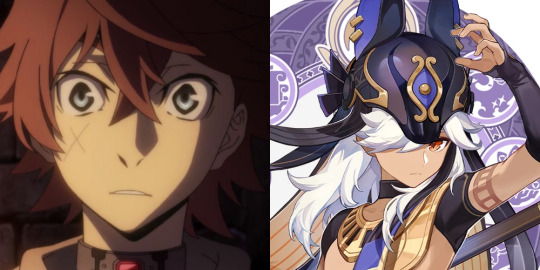
Ono Kensho
Akutagawa - Diluc
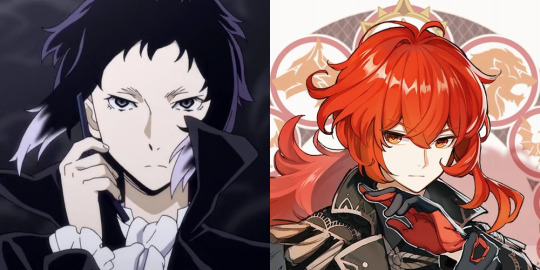
Ami Koshimizu
Kouyou - Beidou
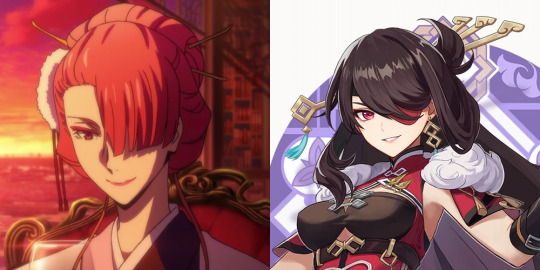
Asami Seto
Higuchi - Kouju Sara

Ayumu Murase
Sugimoto - Venti
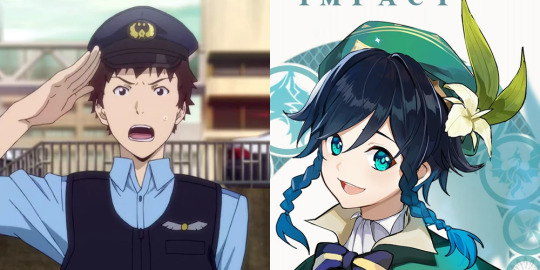
Sanae Kobayashi
Nobuko - Tighnari

Akira Ishida
Fyodor - Ayato

Kousuke Toriumi
Goncharov - Kaeya
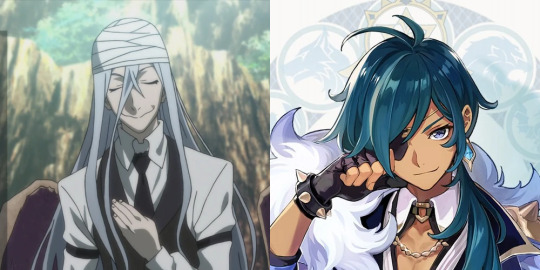
Takeuchi Shunsuke
Lovecraft - Dvalin
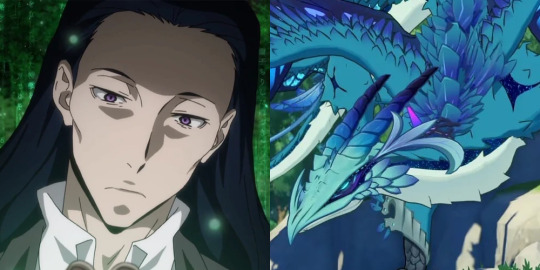
Rie Takahashi
Tsujimura - Hu Tao
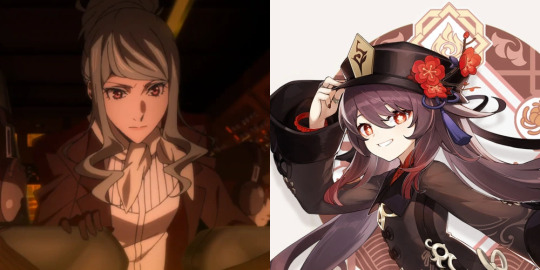
Masakazu Morita
Shōsaku Katsura - Thoma
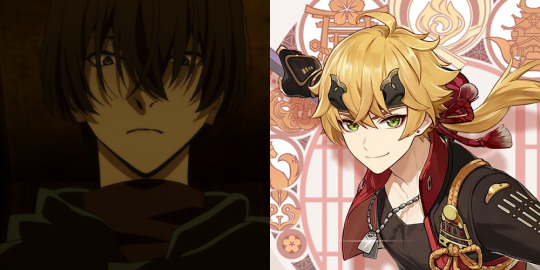
Takanori Hoshino
Yokomizo - Pantalone

Youko Sanpei
Shinji - Mika

ENGLISH VAs
Max Mittelman
Atsushi - Itto
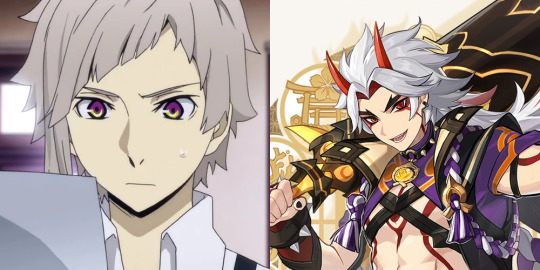
Alejandro Saab
Natsume (Season 4) - Cyno
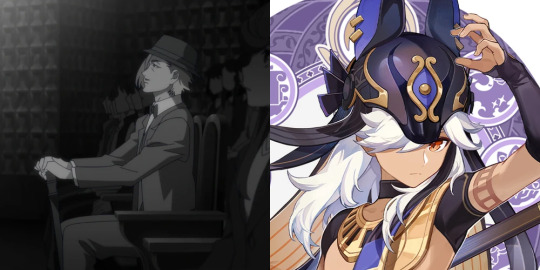
Allegra Clark
Gin - Beidou
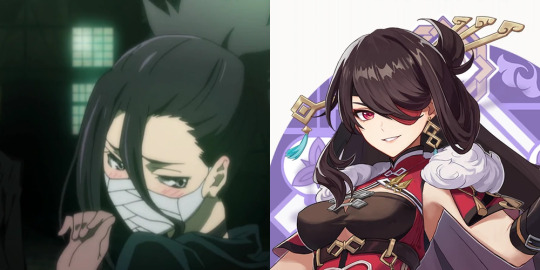
Todd Haberkorn
Poe - Razor

Keith Silverstein
Mori - Zhongli

Chris Hackney
Fitzgerald - Ayato
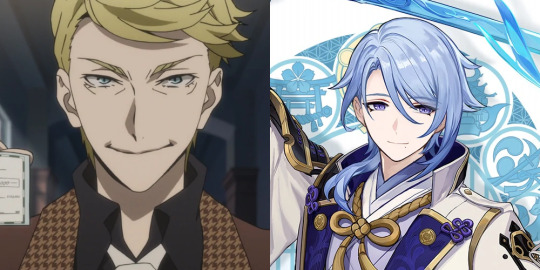
Mick Wingert
Lovecraft - Dottore

Erica Mendez
Luisa - Ayaka (NPCs: Beatrice, Jifang, Katheryne, Marjorie, Timmie)

Christopher Swindle
Rimbaud - Rahman
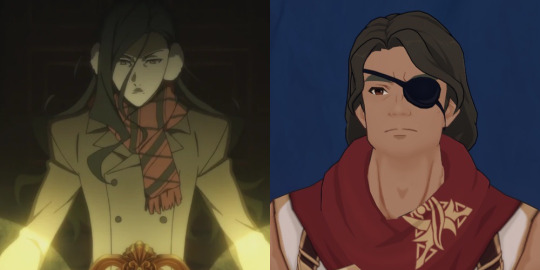
Patrick Seith
Kunikida - Enjou

Carrie Keranen
Higuchi & Elise & Tsujimura - Ying'er & Chizuru

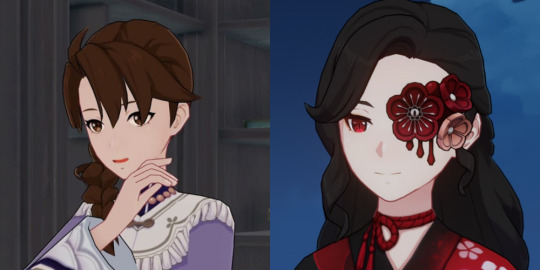
Ryan Colt Levy
Jun Mitamura - Yixuan & Slippery Wu (Other NPCs: Daipai & Pengyi)

Phillip Reich
Mark Twain - Bu'yun

#long post#oh damn#cant wait to have soukoku in genshin lmao /j#bungou stray dogs#bsd#bungo stray dogs#genshin impact#genshin#voice actors#seiyuus#bsd voice actors#genshin voice actors
9 notes
·
View notes
Text
For @thatdazaikin: here is a lengthy post about a small list of works of Kunikida-sensei's that I've read. I'm not sure how to describe his writing except for "it's very Meiji-era" HAHA
Here is a VERY short bio for those who are interested:
Kunikida Doppo (1871-1908) published poetry and short stories which were, depending on who you ask, romantic and/or naturalistic in nature. Regardless of what one might decide his works to be, it can be said that his significance as a Meiji-era author is due to his influence in the birth of Japanese naturalism (considered to be started by Tayama Katai. Yes the BSD refs are real). Throughout his life Kunikida had struggled in many areas of his life - finances, romances, and other personal successes - which shaped his personal views and inevitably his writing.
Sources for everything here: River Mist and Other Stories (tr. David Chibbett) and Five Stories by Kunikida Doppo (Jay Rubin)
(some of) Kunikida-sensei's works casually reviewed by a casual reader
DISCLAIMER: I do not have any formal education in literature, moreover Japanese literature. These personal opinions are from someone who just likes reading and the BSD franchise.
Let me start with my general opinion of Kunikida-sensei: I wouldn't say he's my favorite author of the era (it's Natsume-sensei for the Meiji period for me ehe), but he's quite interesting to say the least.
His writing style is a mix of personal angst and lots of nature descriptions. I can see it being a hindrance for some to enjoy his stories (because it certainly was for me, at least in the beginning) but I do believe it adds a peculiar charm. Hopefully you'll still give his works a shot!
Old Gen
tagging: @requiem626k for this story, jic you might be interested!
This is what Kunikida-sensei himself considers as his true first "work of fiction." It's mostly a tragic story with no reason for being tragic than because it is. The imagery of water and winter here is quite beautiful, I think, but I do feel that although the emotional punch is strong in the end the overall structure of the story could have been more concise. But this is still my favorite work of his (so far, at least).
Unforgettable People
It's half-story, half-essay. Similar to Old Gen the impressionistic descriptions of certain events in the story is quite beautiful, but I think that the strength of this piece lies in its message. My concern with this story is also similar to Old Gen.
Letter from Yugahara
It's one of those "if I could tag Nobuko I would" type of stories. Honestly just a young man being a little dramatic HAHA it's sort of cute yet 100% relatable.
An Honest Man
Honestly, I didn't know what I expected from the title. Certainly not the type of protagonist I expected from Kunikida-sensei, but the central idea is interesting nonetheless. The themes (especially with the woman) I've noticed are quite common in Japanese literature in general (but especially later, up to around Dazai-sensei's time).
River Mist
This is the closest to autobiographical, I think. While most of his works were based on real people, this one echoes his own feelings and frustrations quite well. It's considered to be one of, if not the best of work Kunikida-sensei's. It has a lot of water imagery (again - he really likes water) and children (he really likes children - in the good sense, mind you) that portray the inner torment of the protagonist.
Currently reading: Meat and Potatoes (will edit this post once I'm done I just can't get to reading it without getting hungry HAHA)
--
Well, that's it for now! Maybe you can recommend some of these to your professor? Five Stories (which includes Old Gen, Unforgettable People, and An Honest Man) are free to read on JSTOR so yes. HAHA
#kunikida doppo#japanese literature#should i tag this as bsd lol#i'm going to just post my jlit stuff here lol
11 notes
·
View notes
Text

海 (sea), avant-garde shodo calligraphy by Natsuke Nobuko, early 20th century.
107 notes
·
View notes
Photo

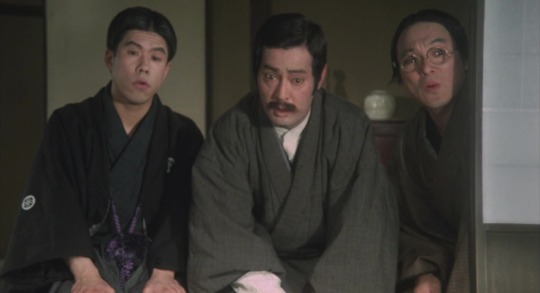




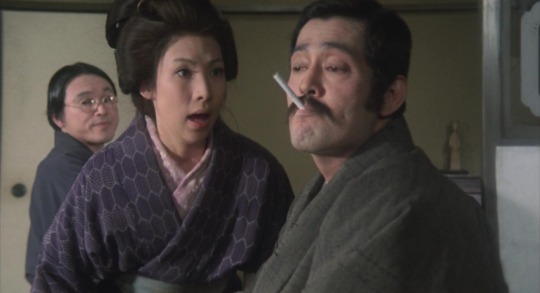
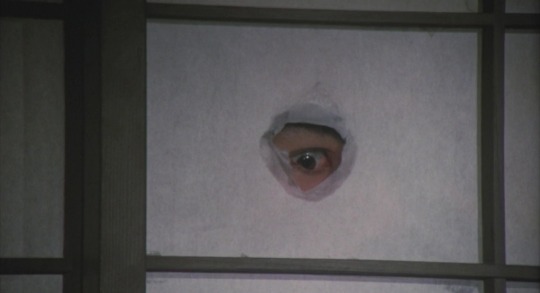


I Am a Cat / Wagahai wa neko de aru (1975, Kon Ichikawa)
吾輩は猫である (市川崑)
1/21/20
#70s#I Am a Cat#Wagahai wa neko de aru#Kon Ichikawa#Soseki Natsume#Tatsuya Nakadai#Kuriko Hano#Juzo Itami#Nobuko Okamoto#Yoko Shimada#Shinsuke Minami#Eiji Okada#Japanese#book adaptation#literary#conversations#storytelling#intellectuals#teachers#Meiji#19th Century#westernization#satire#cats#pets#comedy#gossip#neighbors
9 notes
·
View notes
Text
The Case Files of Jeweler Richard, online un primo teaser dell’anime
Svelati staff e cast della serie animata tratta dal romanzo di Nanako Tsujimura.
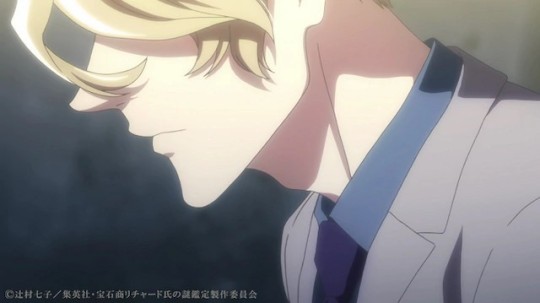
Diffuso un primo breve video promozionale serie per la animata basata sulla light novel “Housekishou Richard-shi no Nazo Kantei” (The Case Files of Jeweler Richard) di Nanako Tsujimura, che andrà in onda da gennaio 2020.
Assieme al teaser è stato svelato lo staff al lavoro presso lo studio Shuka (91 Days, Durarara!!x2, Natsume Yuujinchou Roku), che vede alla regia Tarou Iwasaki (Ishuukan Friends, Amaama to Inazuma) e alla sceneggiatura Mariko Kunisawa (Ascendance of a Bookworm, Hatsukoi Limited, Magimoji Rurumo). Il character design e le animazioni sono supervisionati da Natsuko Kondou (direttore d’animazione in Karakai Jouzu no Takagi-san).
youtube
Altri membri dello staff sono:
Supervisione movenze di Richard: Masakazu Kawazoe
Supervisione rappresentazione gioielli: Naokazu Kudou
Musiche: Nobuko Toda
Fondali: Mio Isshiki
Colorista: Ritsuko Utagawa
Produzione Computer grafica: Norikazu Kamibayashi
Compositing/Direttore della fotografia: Tomoyuki Shiokawa
Montaggio: Daisuke Imai
Direttore del suono: Satoshi Motoyama
I design e i doppiatori dei due protagonisti invece sono:
Richard Ranashinha Dvorpian: Takahiro Sakurai
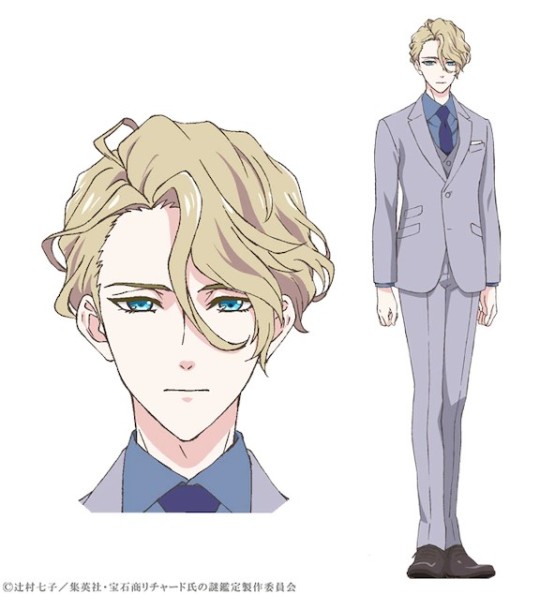
Seigi Nakata: Yuuma Uchida

La storia segue il bel perito di gioielli britannico Richard Ranashinha Dvorpian e lo studente universitario giapponese Seigi Nakata, nel mentre che i due risolvono vari casi legati ai gioielli e svelano le verità nascoste dietro alle preziose gemme.
Shueisha ha lanciato la novel in versione cartacea nel 2015, corredata delle illustrazioni realizzate da Utako Yukihiro (Devils and Realist, Uta no Prince-sama, B-PROJECT). Fino al 6° volume, l’opera è una raccolta di storie brevi, mentre dal 7° la storia avanza sotto forma di romanzo vero e proprio; lo scorso 21 agosto ne è stato pubblicato il 9° tomo.
Autore: SilenziO))) (@s1lenzi0)
[FONTE]
#housekishou richard-shi no nazo kantei#the case files of jeweler richard#anime#serie tv#manga#light novel#slice of life#gioielli#cartoni animati#animazione#newsintheshell#news in the shell
0 notes